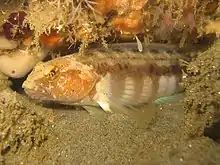| Rathbunella | |
|---|---|
 | |
| Stripefin Ronquil (R. hypoplecta) | |
| Scientific classification | |
| Domain: | Eukaryota |
| Kingdom: | Animalia |
| Phylum: | Chordata |
| Class: | Actinopterygii |
| Order: | Scorpaeniformes |
| Family: | Bathymasteridae |
| Genus: | Rathbunella D. S. Jordan & Evermann, 1896 |
| Type species | |
| Bathymaster hypoplectus | |
Rathbunella is a genus of marine ray-finned fishes belonging to the family Bathymasteridae, the ronquils. These fishes are found in the eastern Pacific Ocean.
Taxonomy
Rathbunella was first proposed as a monotypic genus by the American ichthyologists David Starr Jordan and Barton Warren Evermann in 1896 with Bathymaster hypoplectus, which had been described by Charles Henry Gilbert from Southern California in 1890, as its type species.[1][2] The genus is classified in the family Bathymasteridae which is in the Scorpaeniform suborder Zoarcoidei.[3] The genus name,Rathbunella honors Richard Rathbun, who was the chief of the Division of Scientific Inquiry in the United States Fish Commission, in recognition of his services to science.[4]
Species
There are currently two recognized species in this genus:[5]
- Rathbunella alleni Gilbert, 1904
- Rathbunella hypoplecta (Gilbert, 1890) (Stripefin ronquil)
Characteristics
Rathbunella ronquils are distinguished from other genera in the family Bathymasteridae by having the branchiostegal membranes being broadly united , free from isthmus, creating a thick fold. Their gill rakers are short and robust, with small patches of teeth. There are around 100 vomerine teeth which are arranged in concentric arcs which number between 7 and 9. They have between 72 and 88 pored scales in the lateral line. Unlike Bathymaster but like Ronquilus there are scales on the cheeks and crown.[6] The only species for which a maximum published length is given is R. hypoplecta with a total length of 16 cm (6.3 in).[5]
Distribution, habitat and biology
Rathbunella ronquils are found in the eastern North Pacific Ocean where they are distributed from San Francisco Bay in northern California south to Bahia San Carlos in Baja California.[7] They are solitary, demersal fishes of shallow coastal waters in rocky areas.[8] The demersal eggs are guarded by the males.[6]
References
- 1 2 Eschmeyer, William N.; Fricke, Ron & van der Laan, Richard (eds.). "Genera in the family Bathymasteridae". Catalog of Fishes. California Academy of Sciences. Retrieved 28 July 2022.
- ↑ Eschmeyer, William N.; Fricke, Ron & van der Laan, Richard (eds.). "Species in the genus Rathbunella". Catalog of Fishes. California Academy of Sciences. Retrieved 28 July 2022.
- ↑ J. S. Nelson; T. C. Grande; M. V. H. Wilson (2016). Fishes of the World (5th ed.). Wiley. pp. 478–482. ISBN 978-1-118-34233-6.
- ↑ Christopher Scharpf & Kenneth J. Lazara, eds. (4 July 2021). "Order Perciformes (Part 11): Suborder Cottoidea: Infraorder Zoarcales: Families: Anarhichadidae, Neozoarcidae, Eulophias, Stichaeidae, Lumpenidae, Ophistocentridae, Pholidae, Ptilichthyidae, Zaproridae, Cryptacanthodidae, Cebidichthyidae, Scytalinidae and Bathymasteridae". The ETYFish Project Fish Name Etymology Database. Christopher Scharpf and Kenneth J. Lazara. Retrieved 28 July 2022.
- 1 2 Froese, Rainer and Pauly, Daniel, eds. (22213). Species of Rathbunella in FishBase. February 22213 version.
- 1 2 Stevenson, Duane; Ann C. Matarese (2005). "The ronquils: a review of the North Pacific fish family Bathymasteridae (Actinopterygii: Perciformes: Zoarcoidei)". Proceedings of the Biological Society of Washington. 118: 367–406. doi:10.2988/0006-324X(2005)118[367:TRAROT]2.0.CO;2.
- ↑ Mecklenburg, C. W. (2003). "Family Bathymasteridae Jordan & Gilbert 1883 — ronquils" (PDF). California Academy of Sciences Annotated Checklists of Fishes No. 7. California Academy of Sciences.
- ↑ "Bluebanded Ronquil". Mexican Fish. Retrieved 28 July 2022.